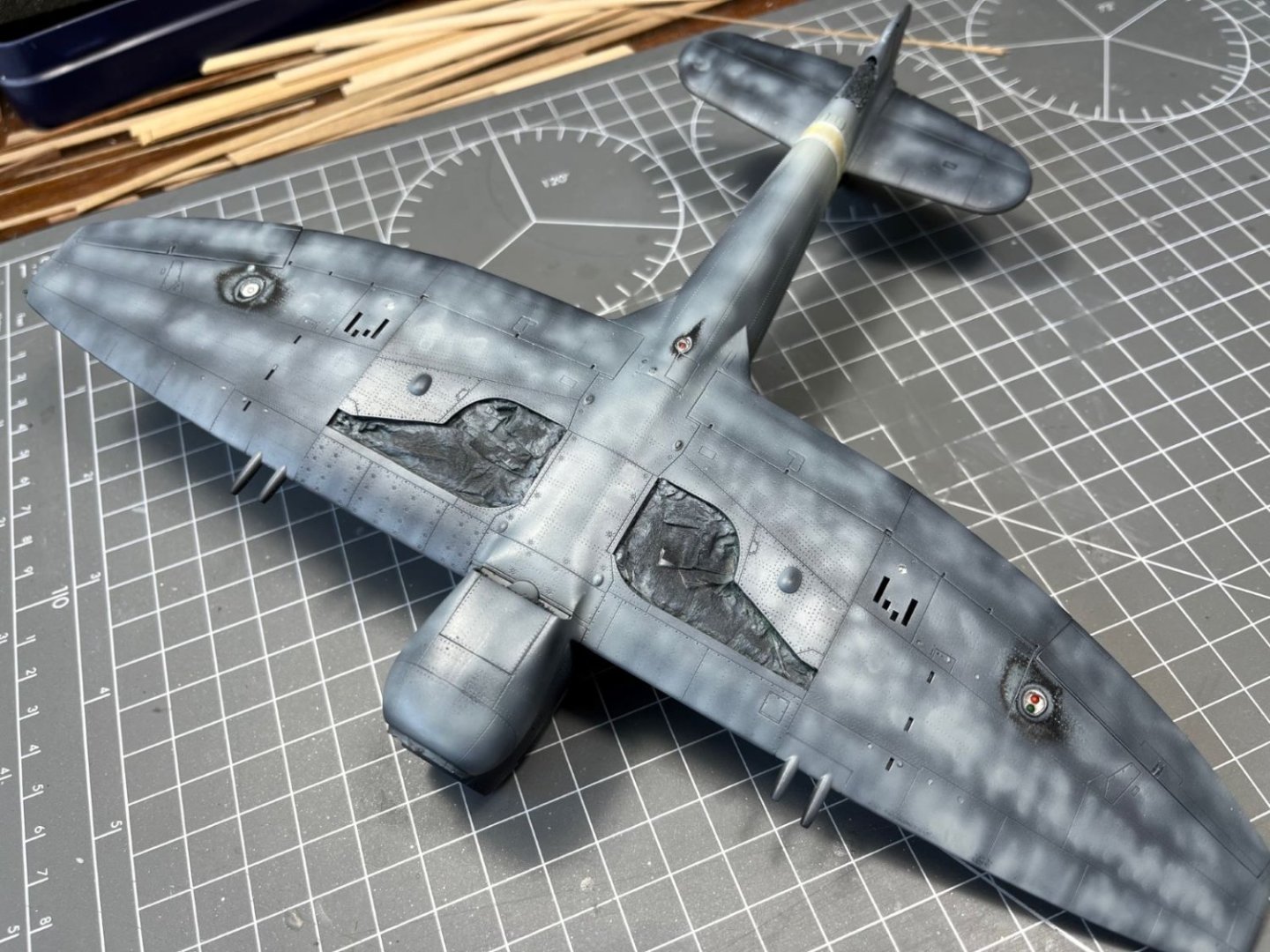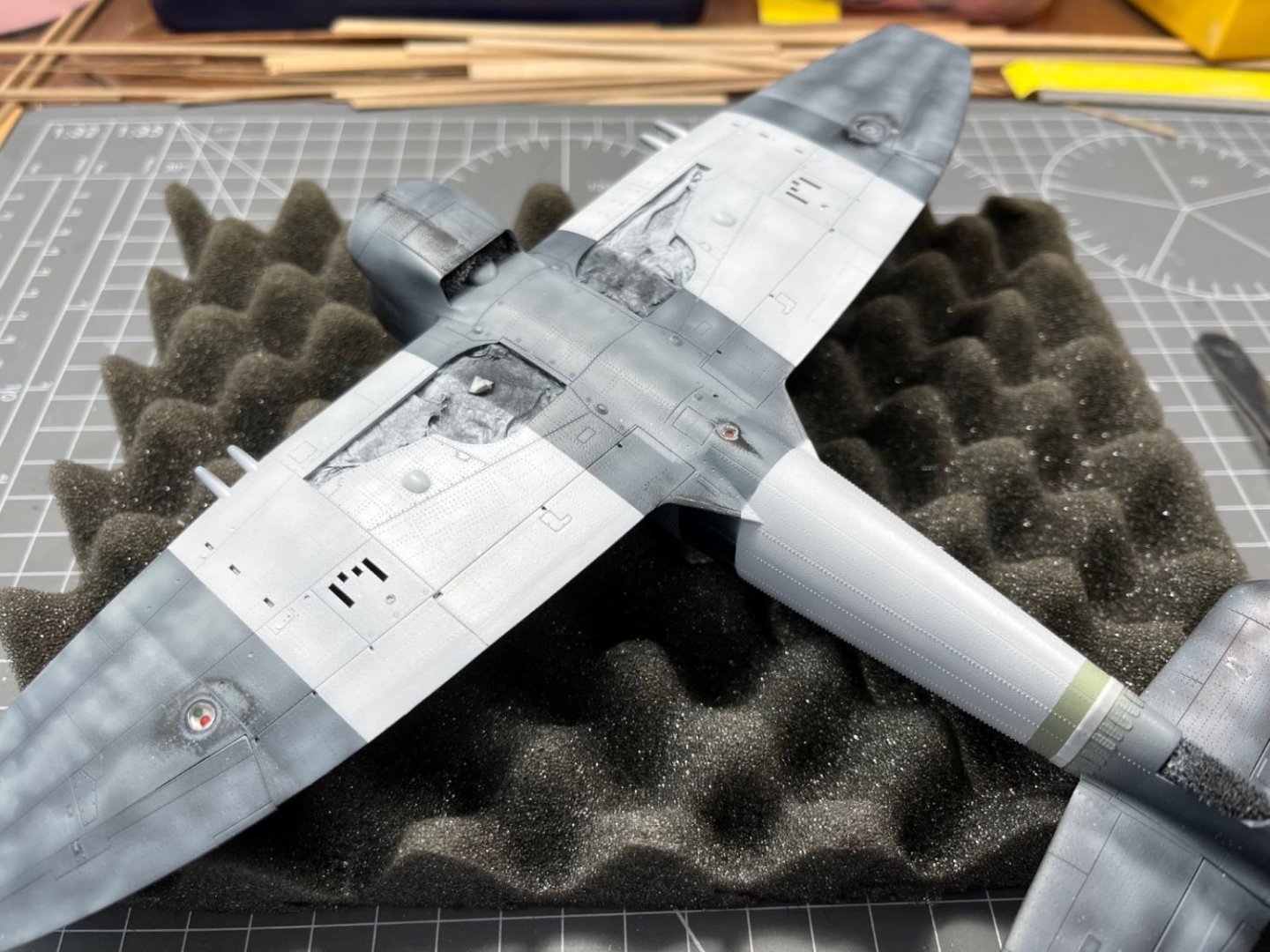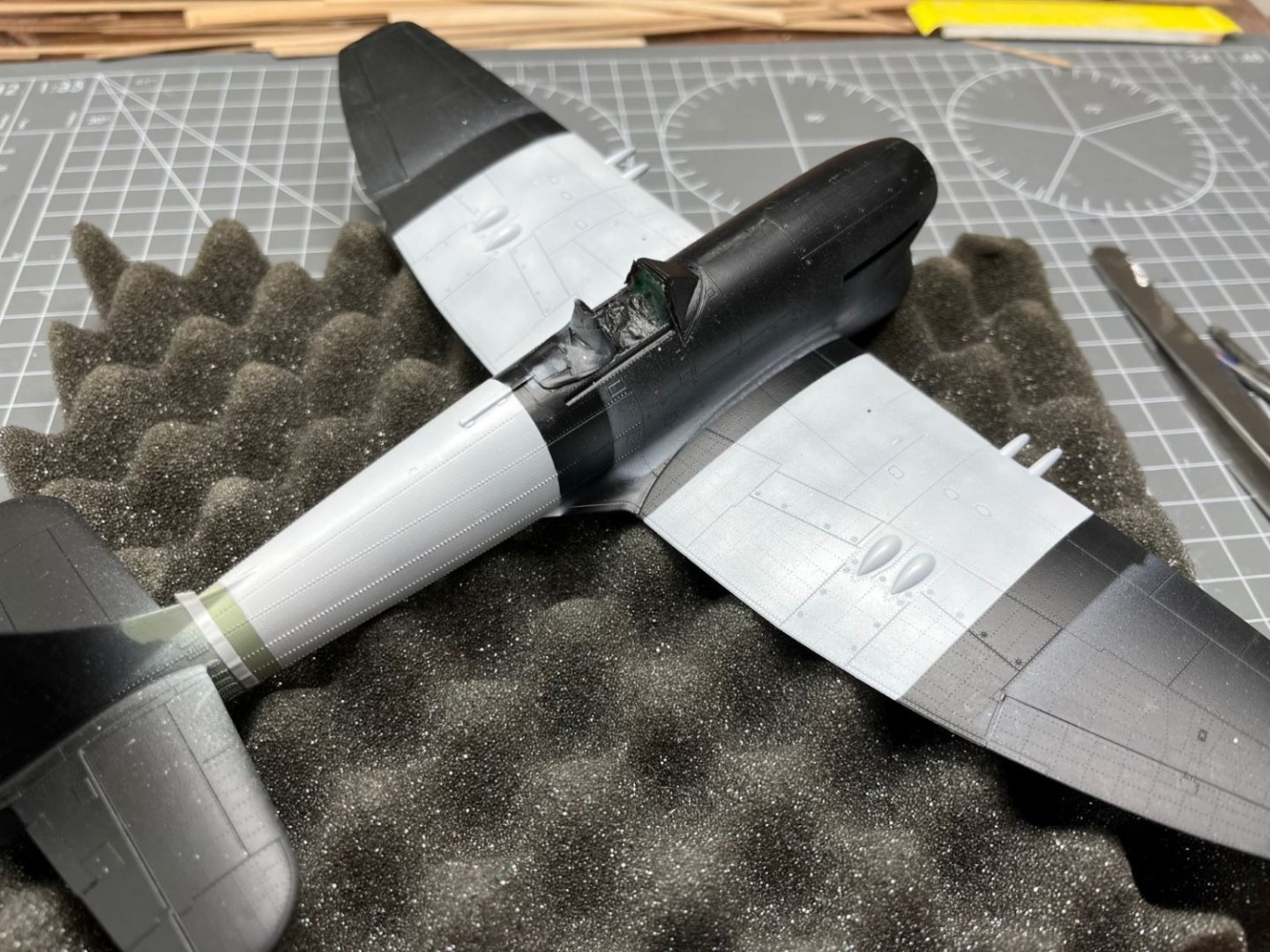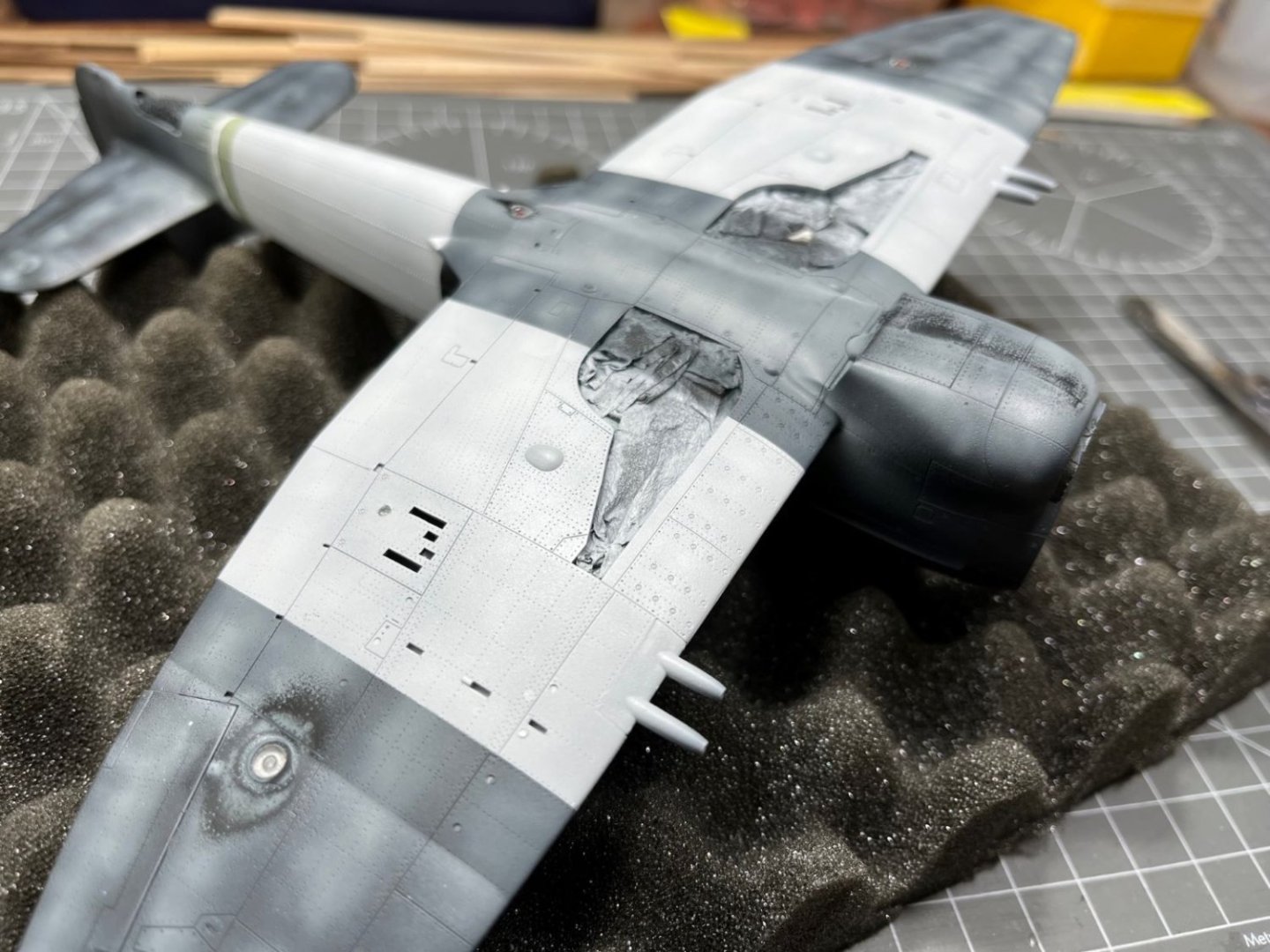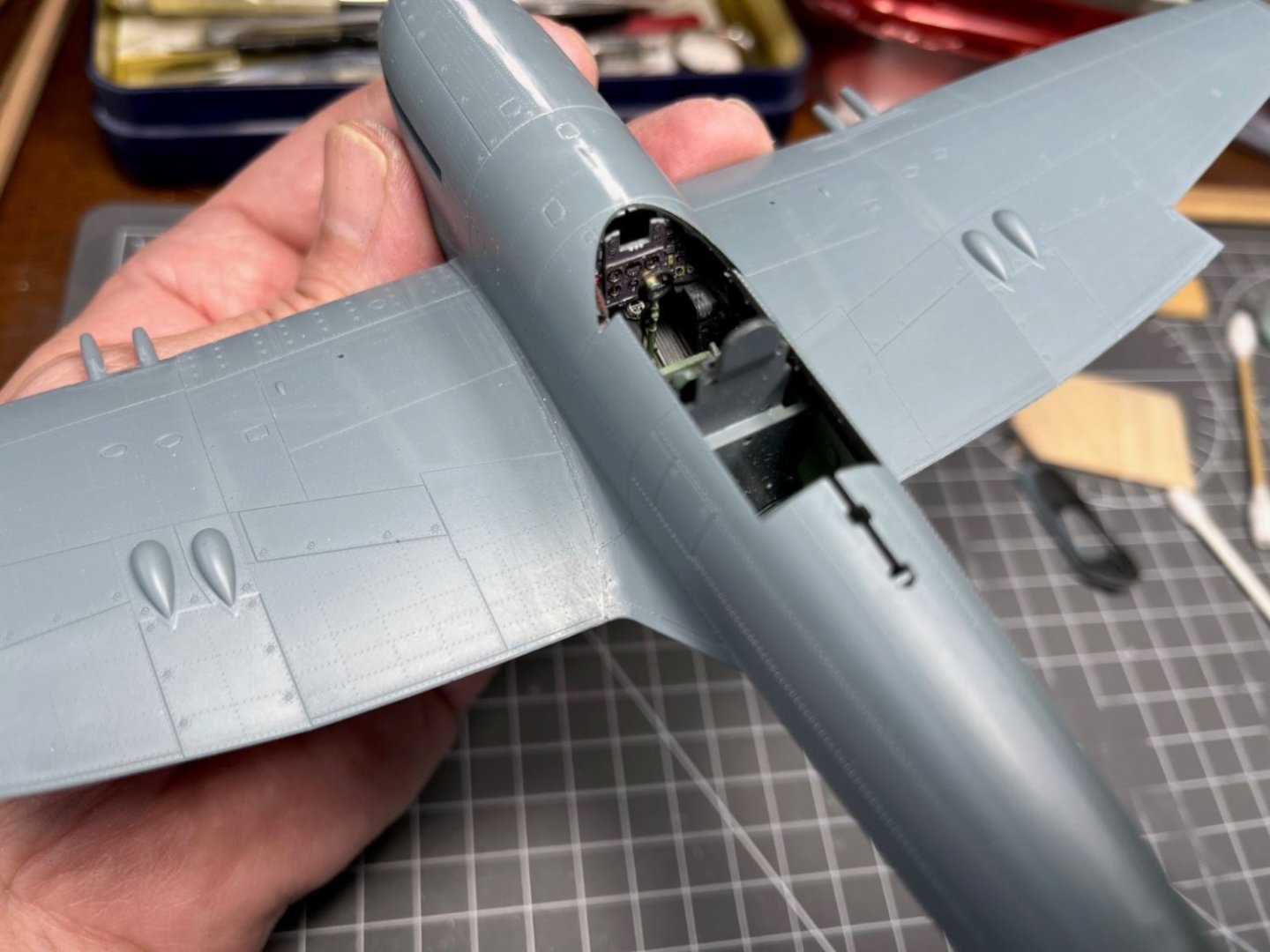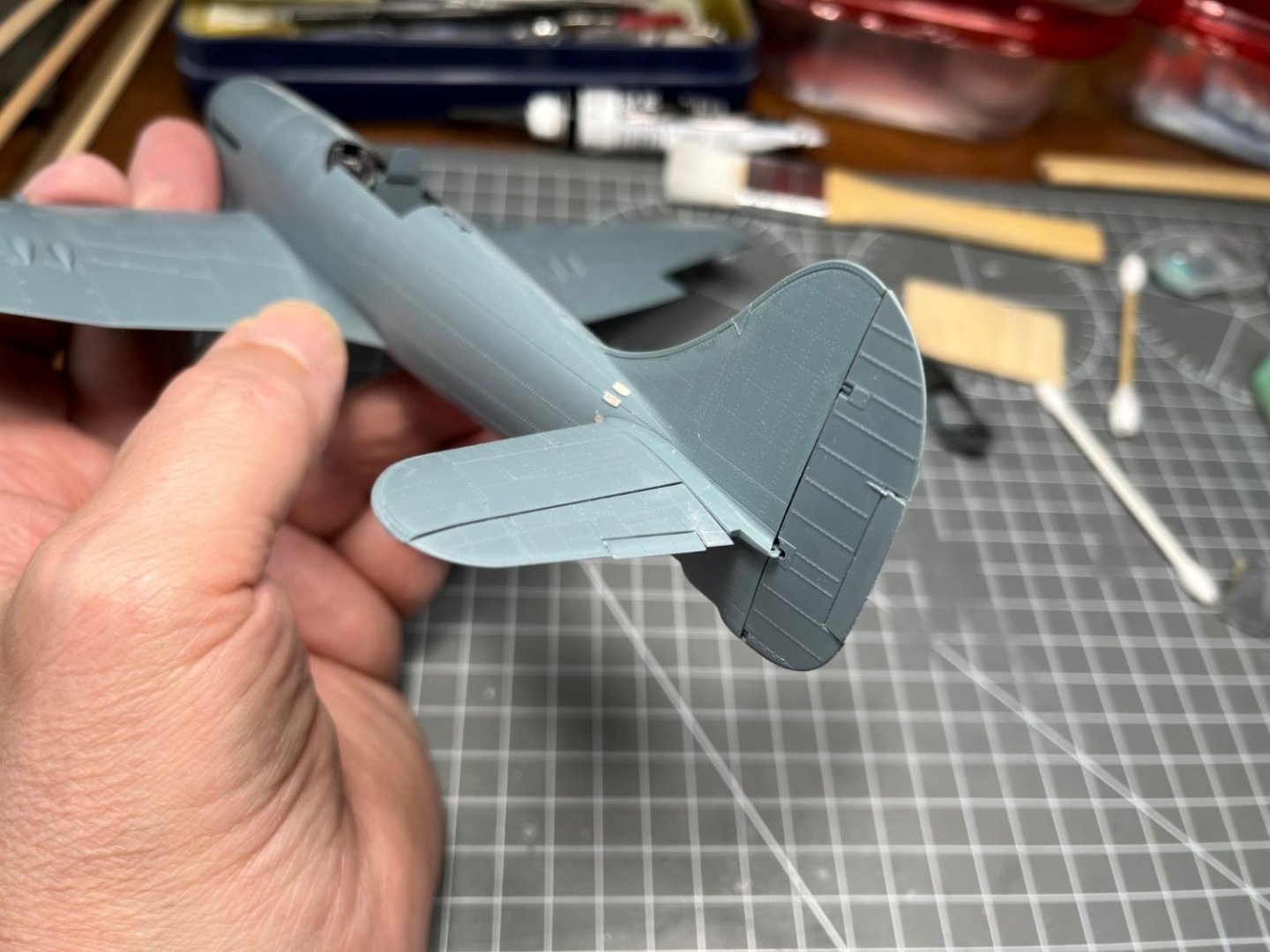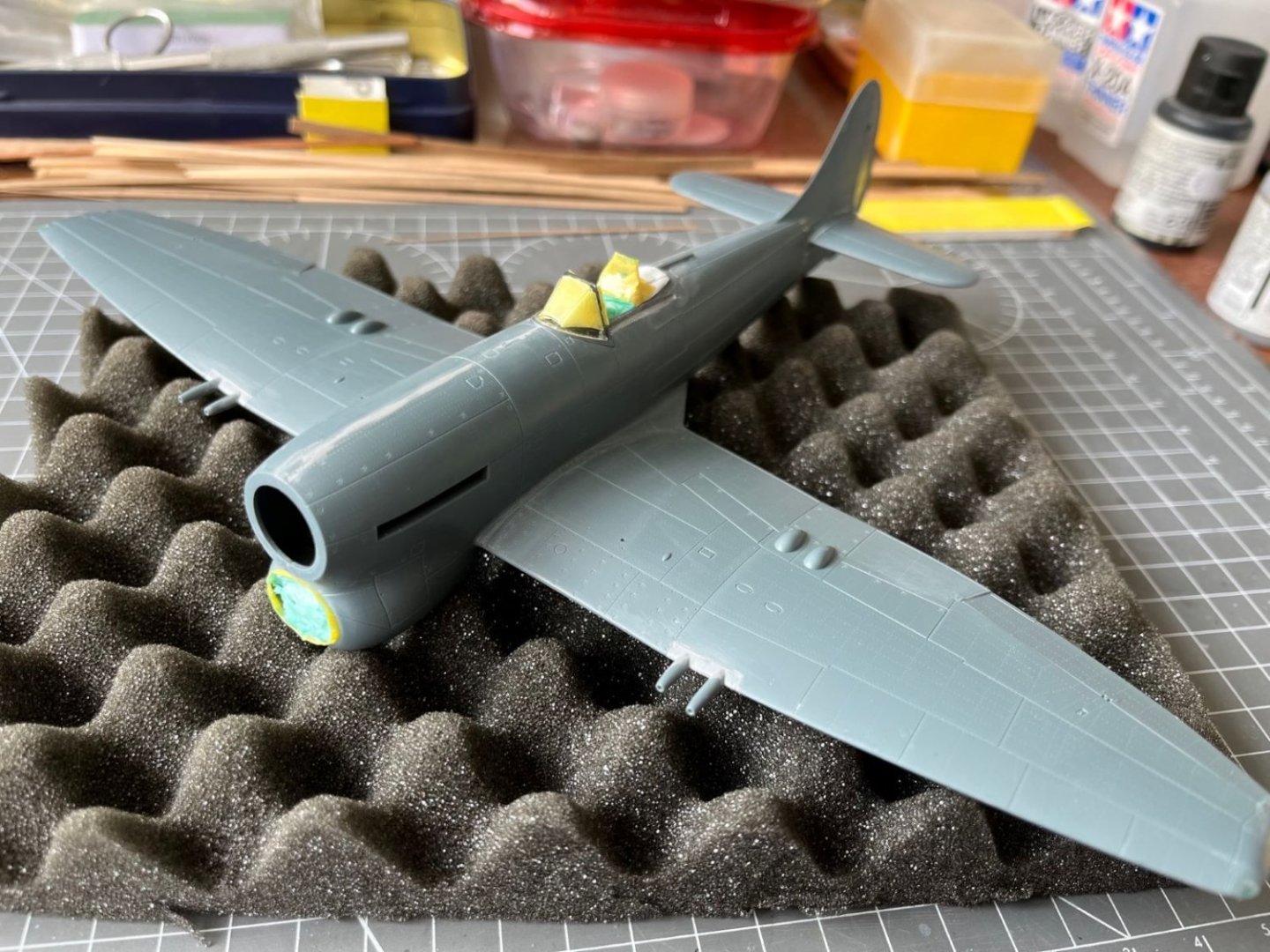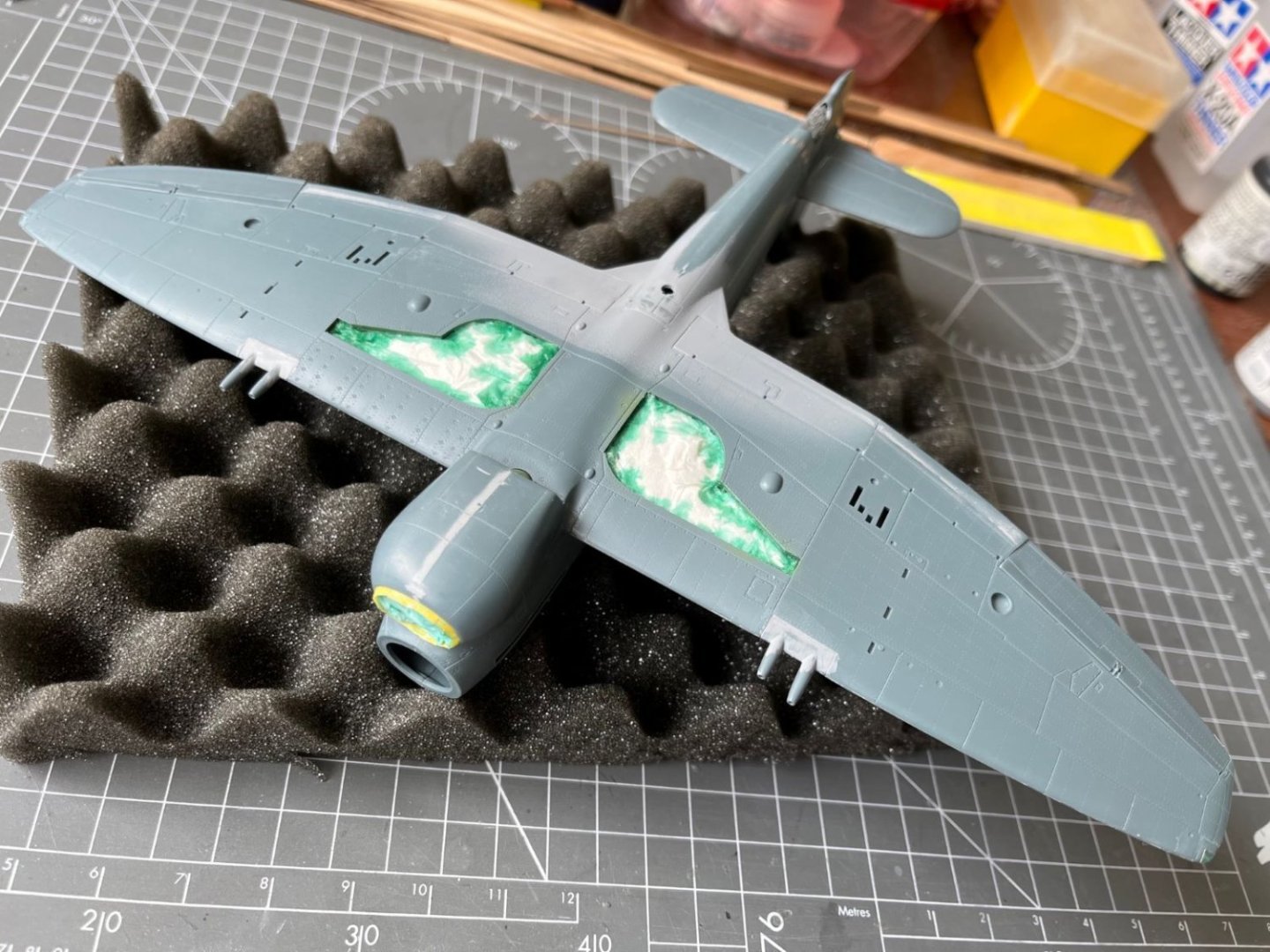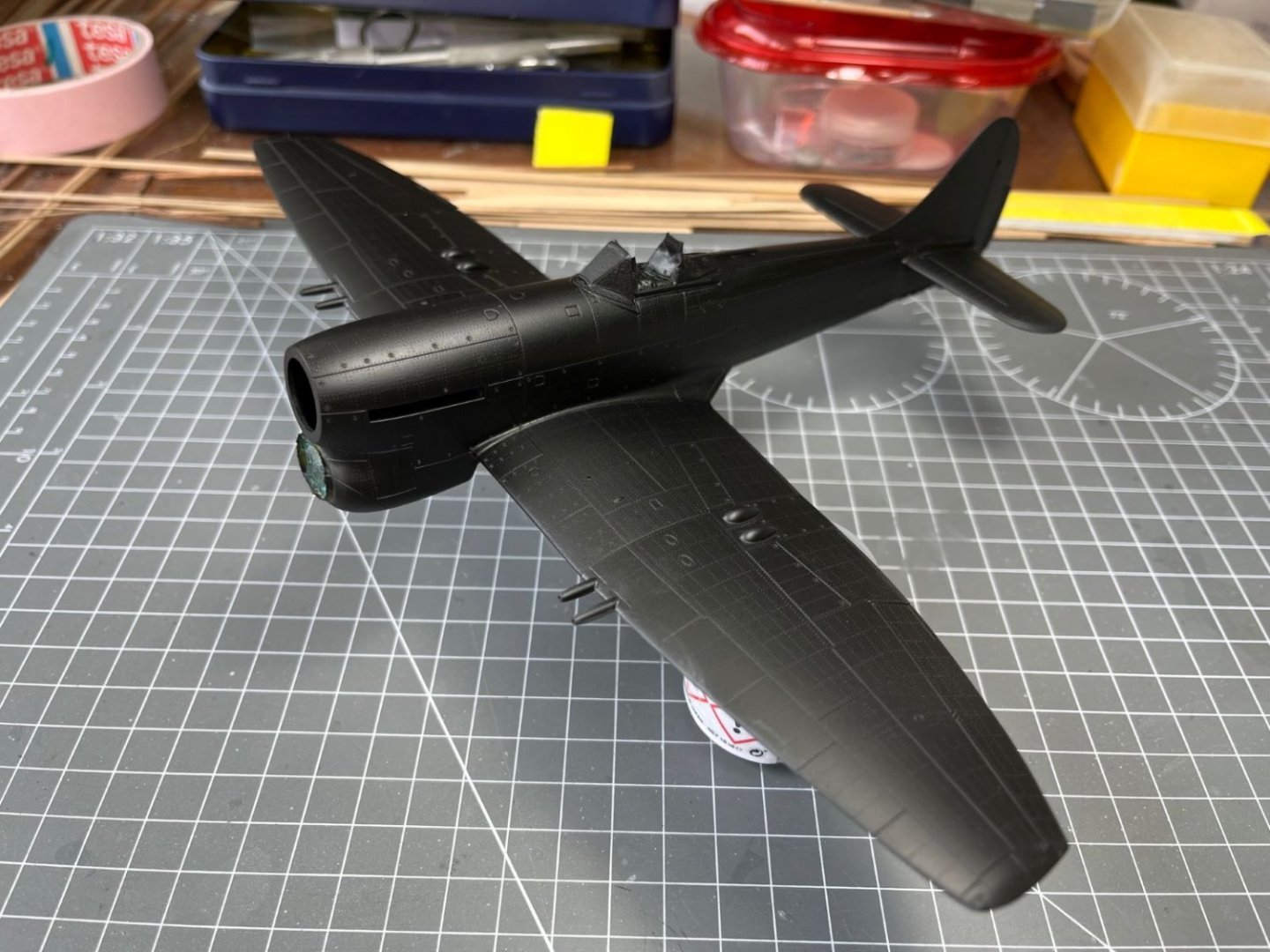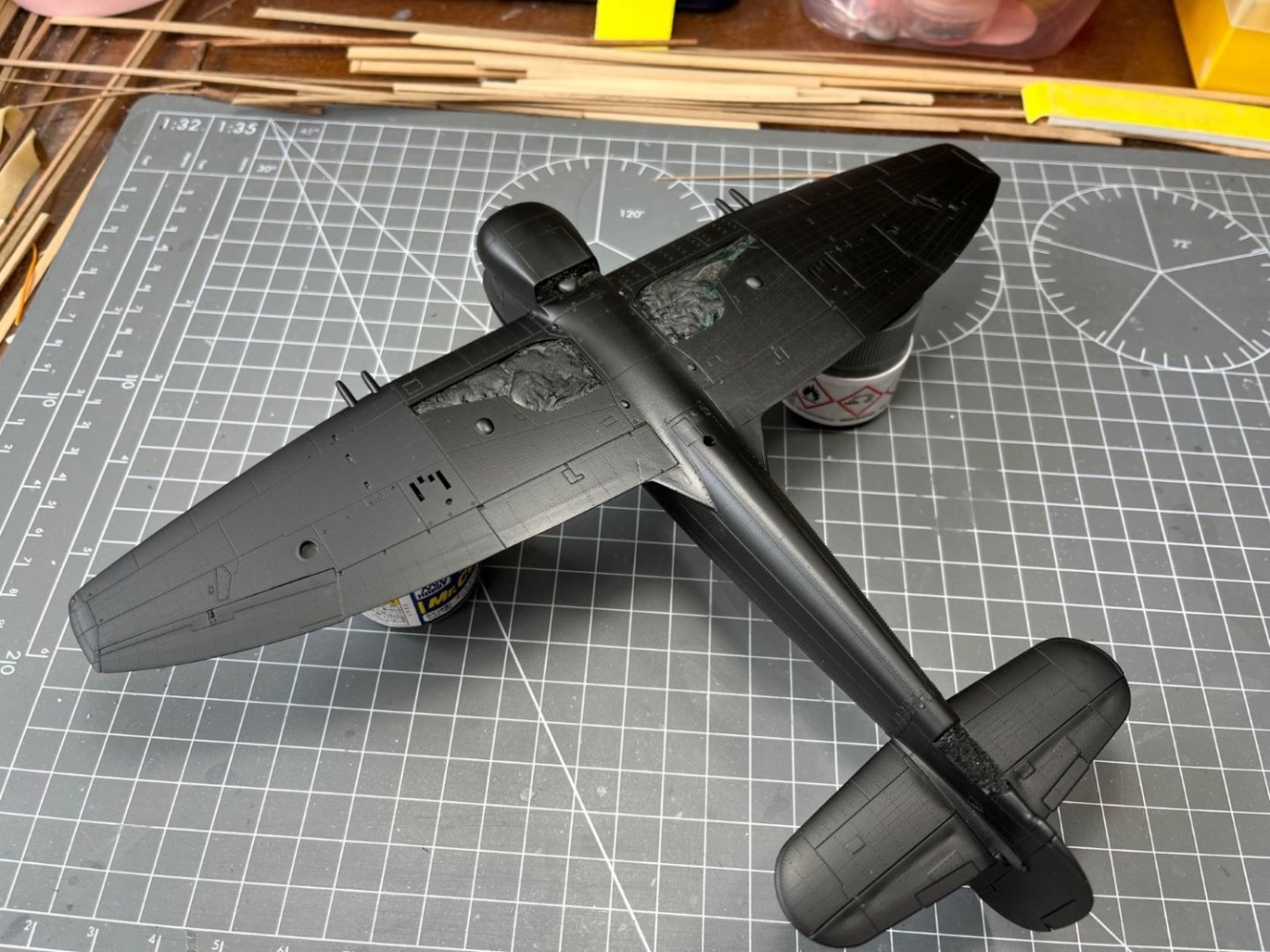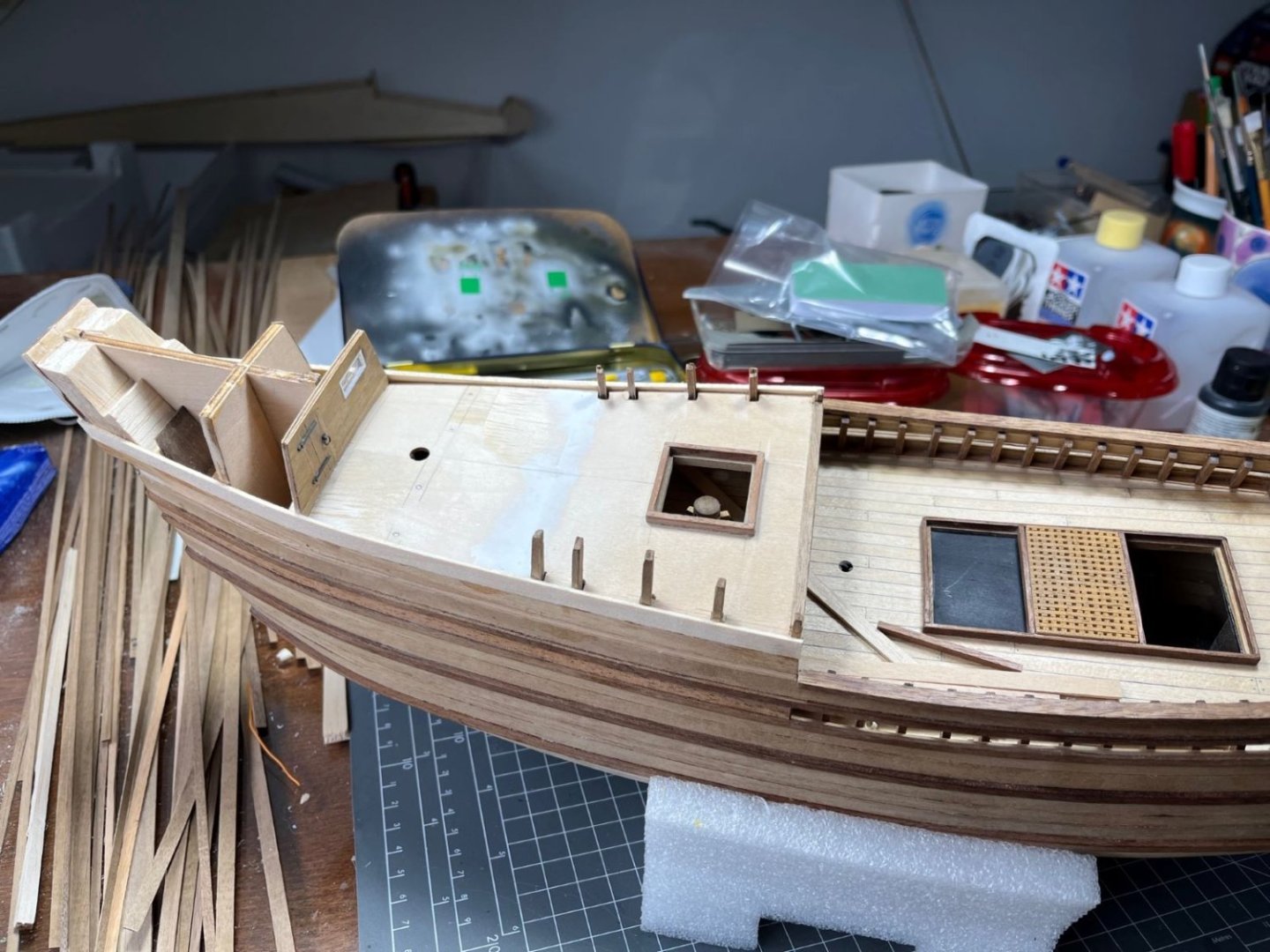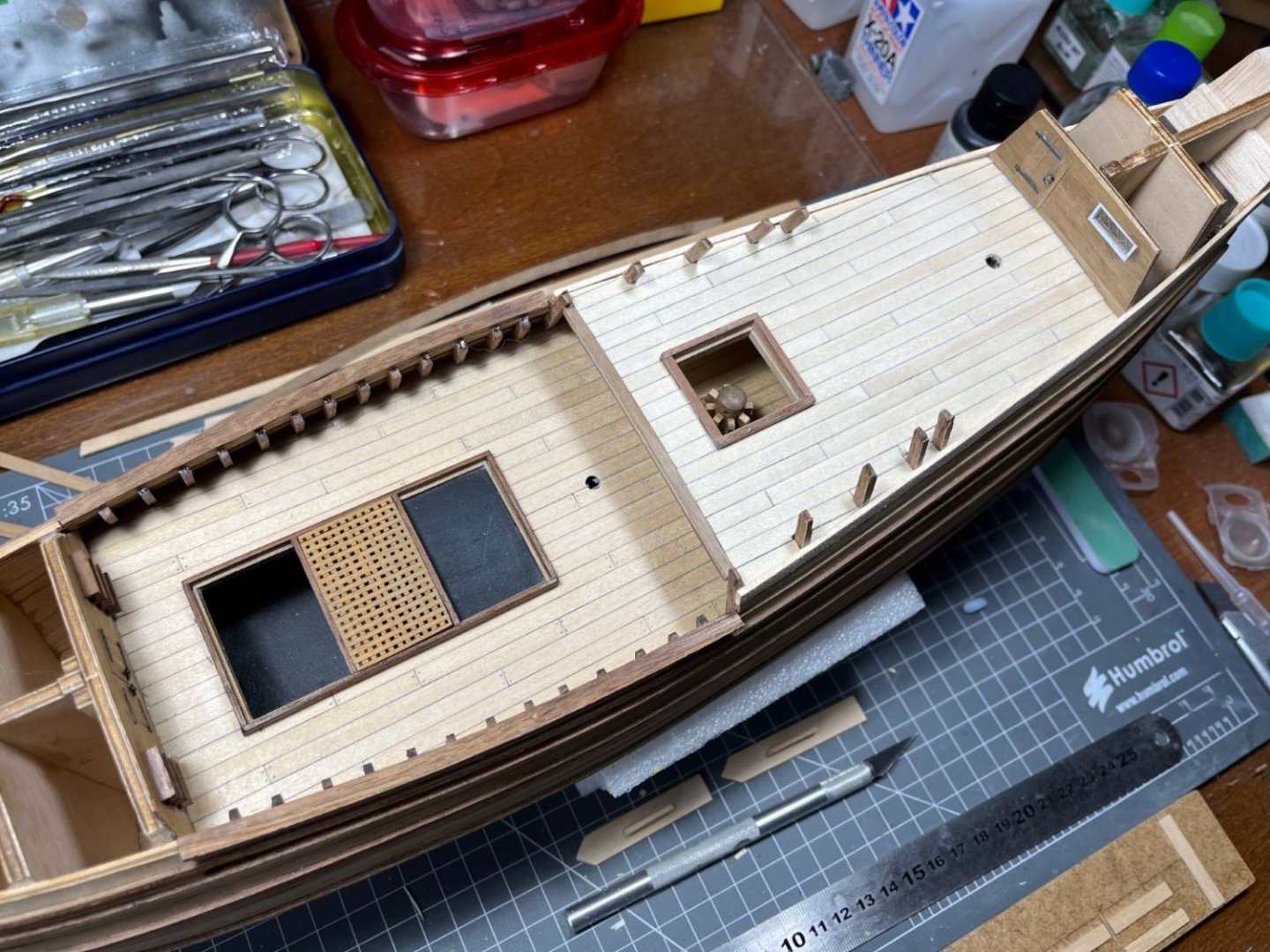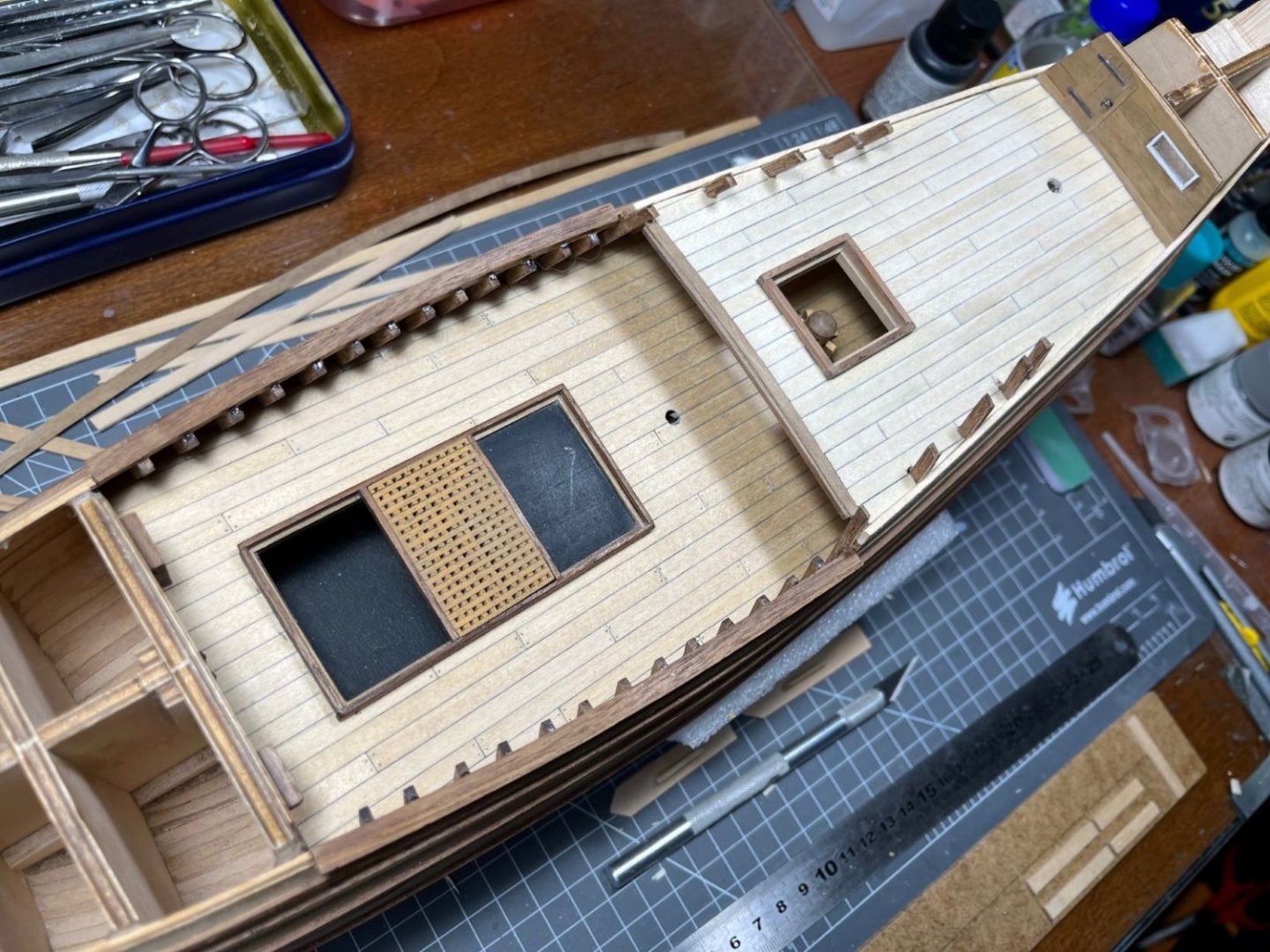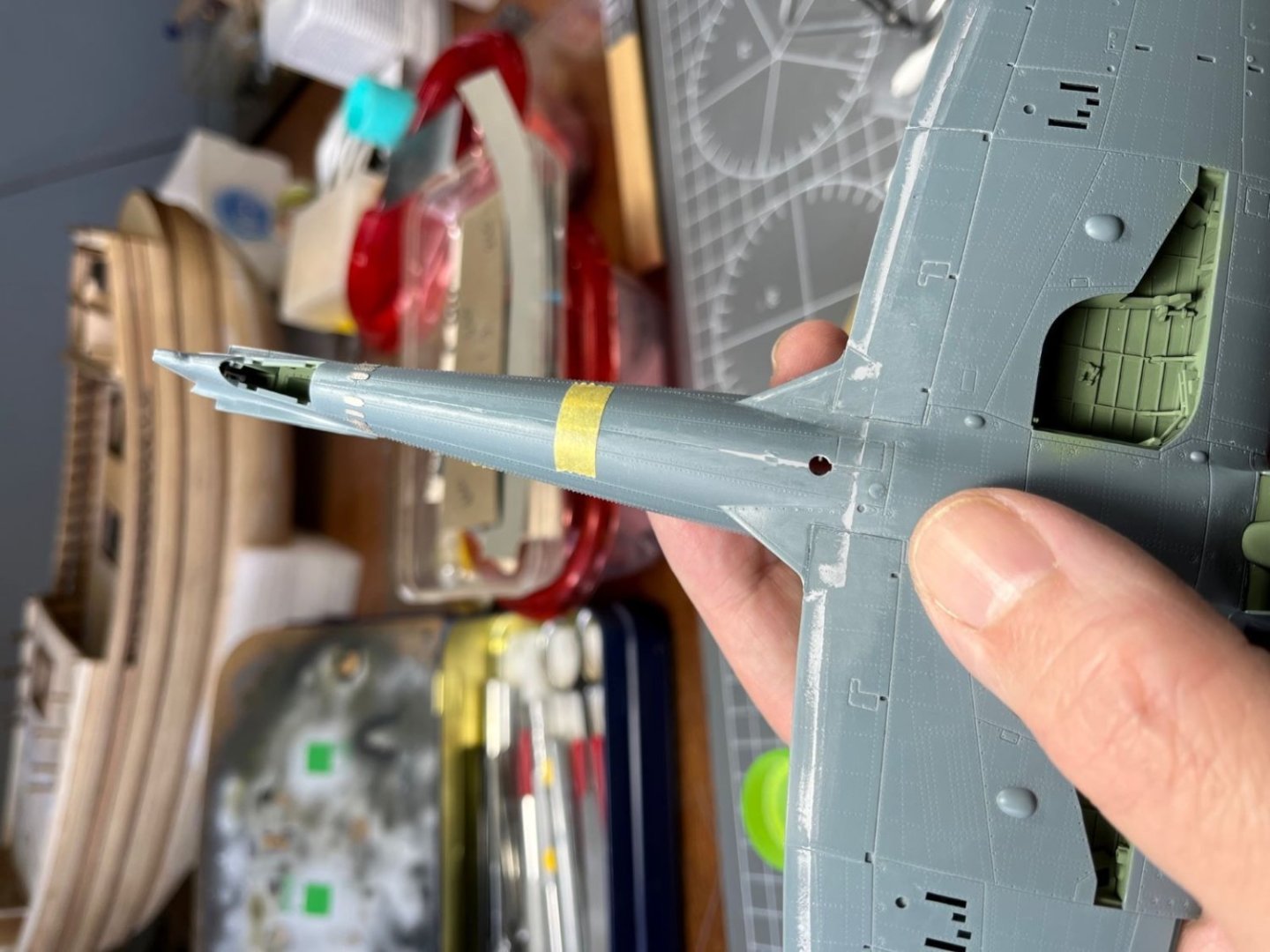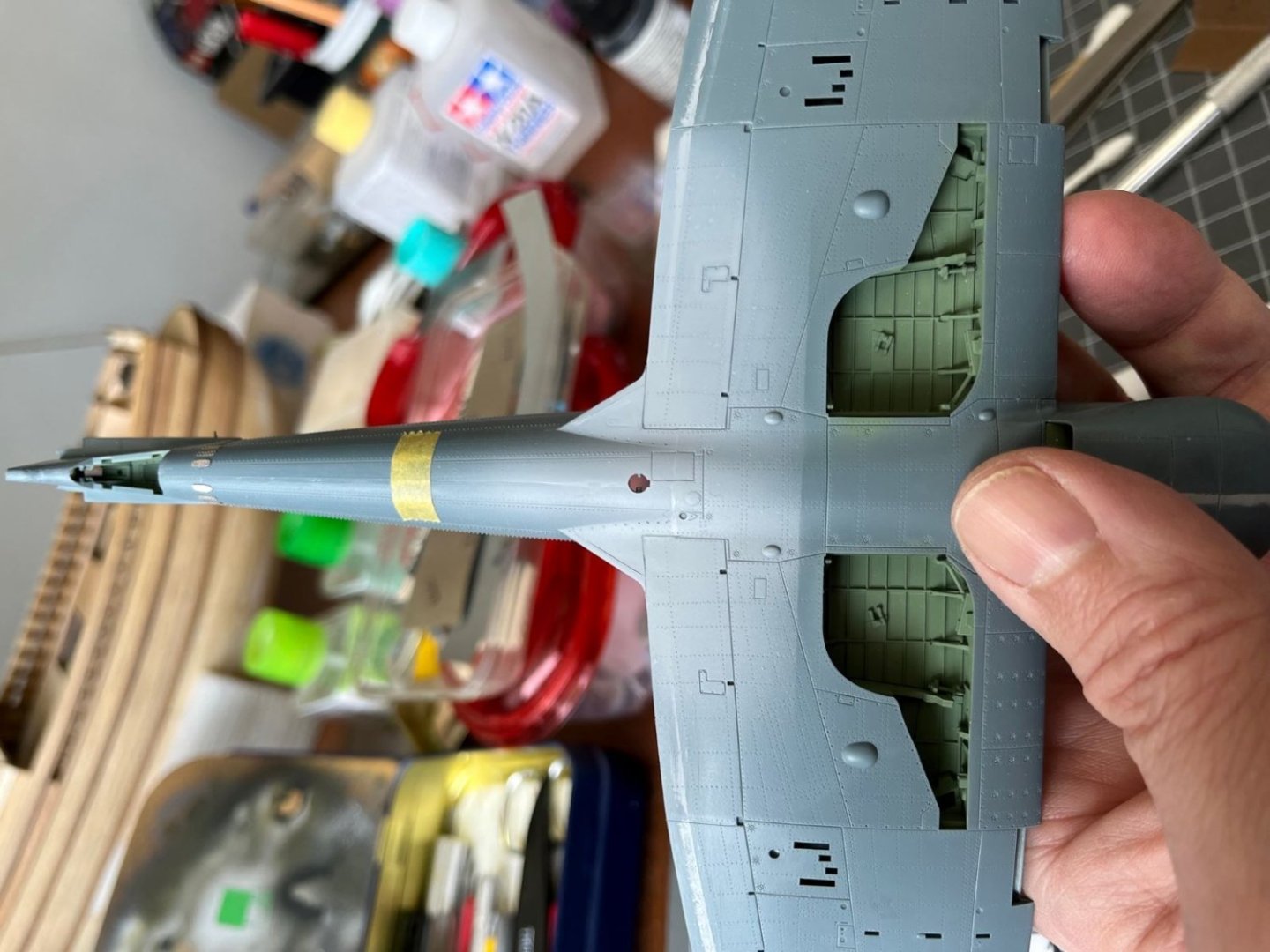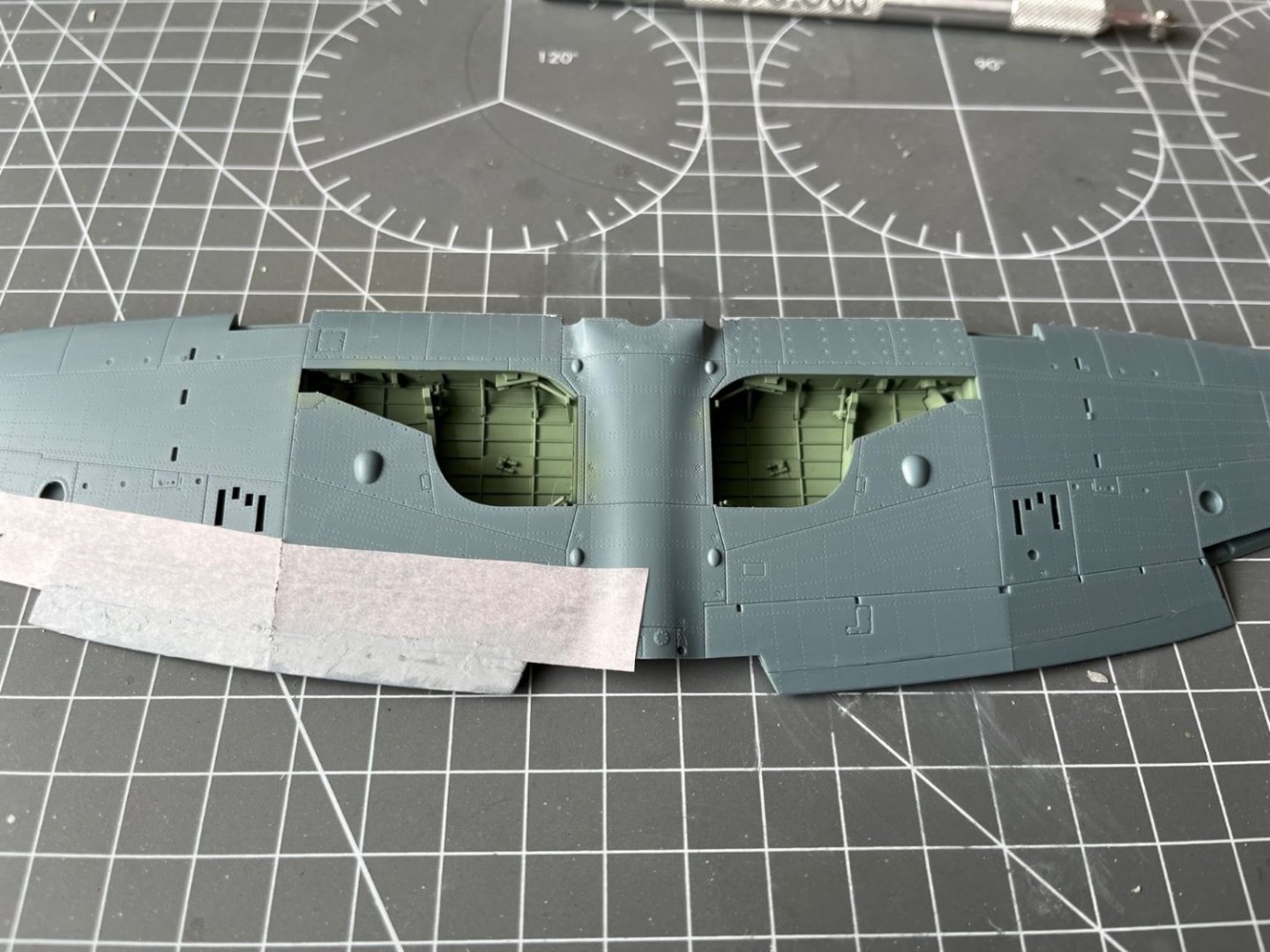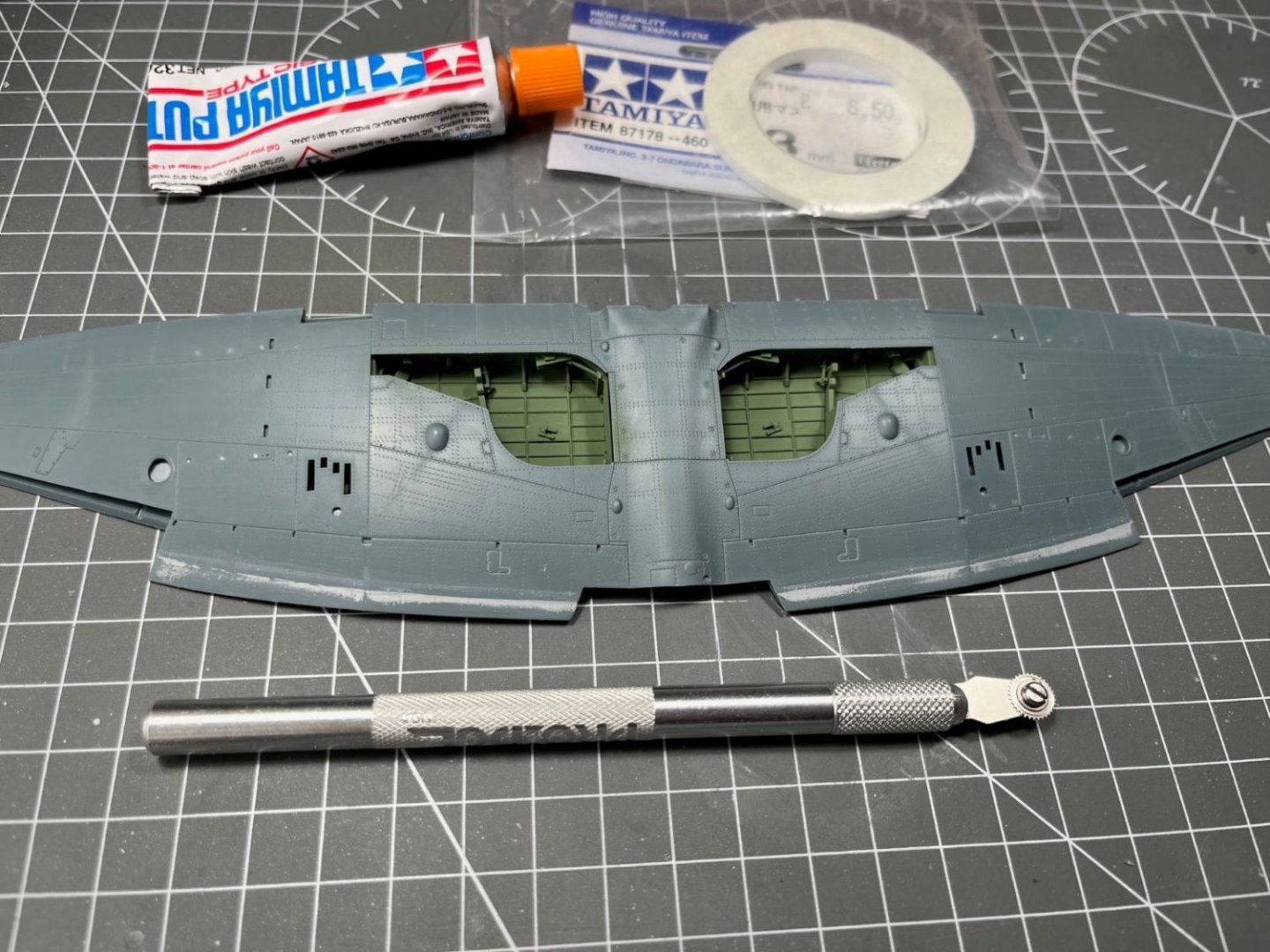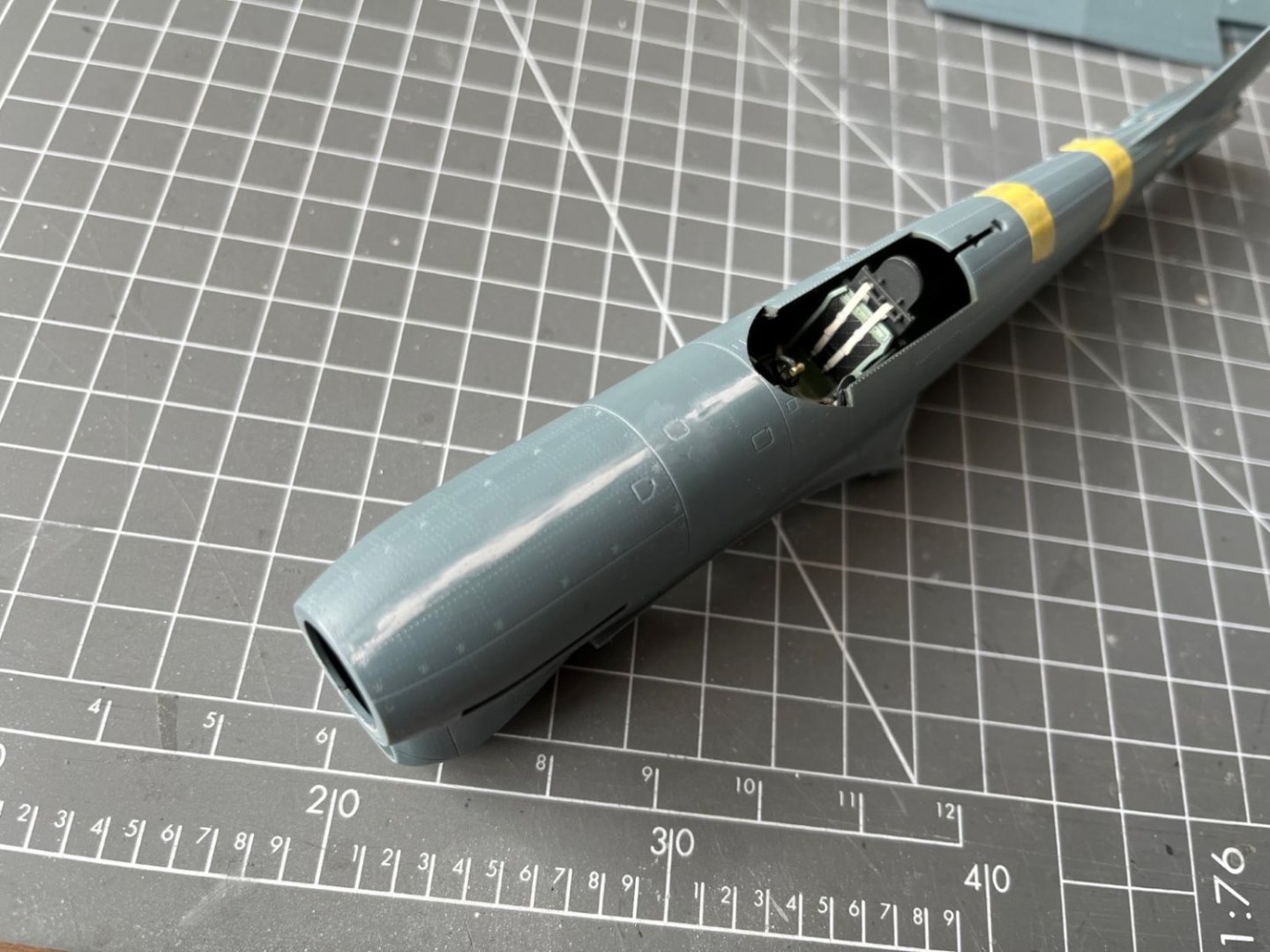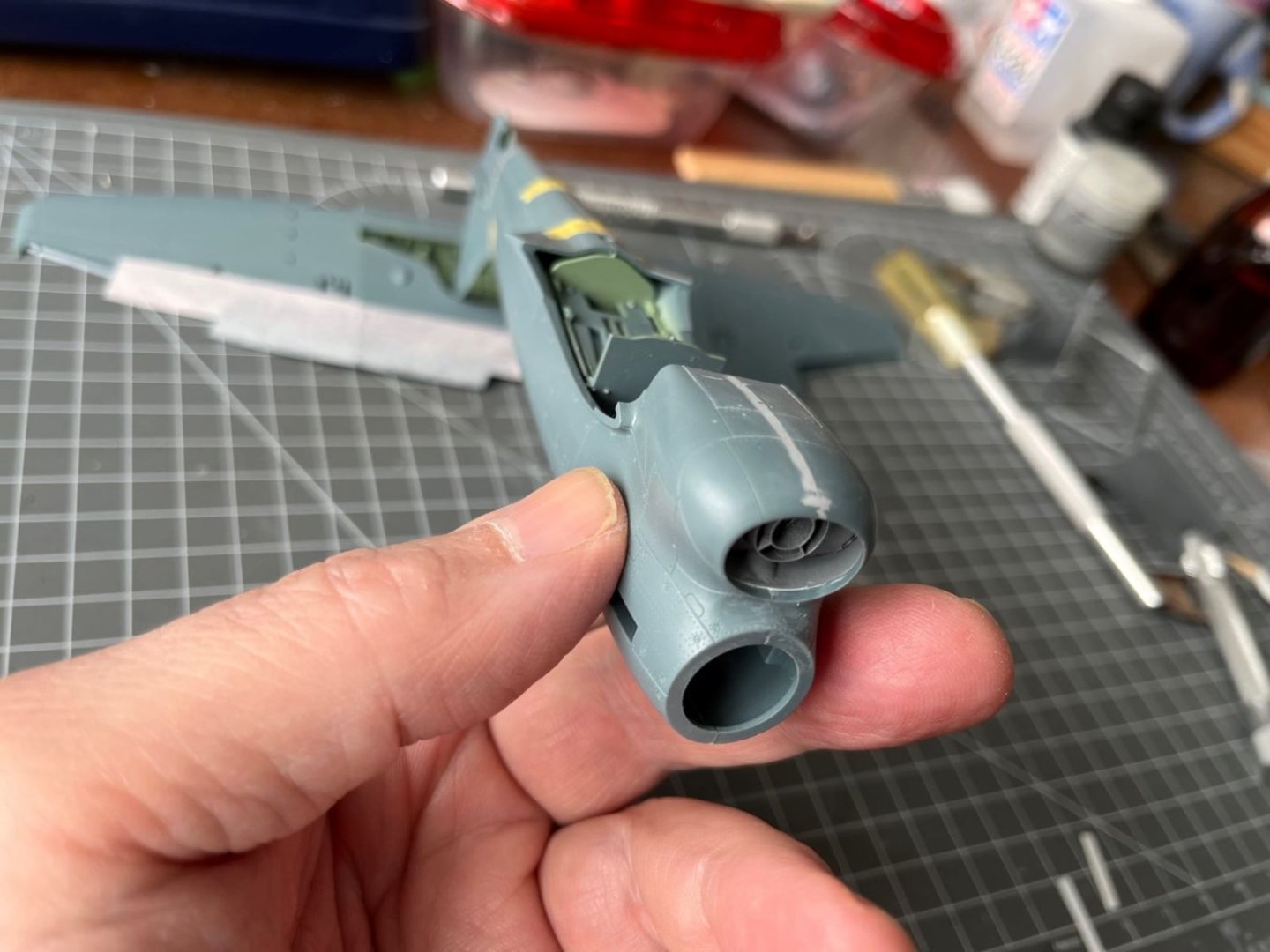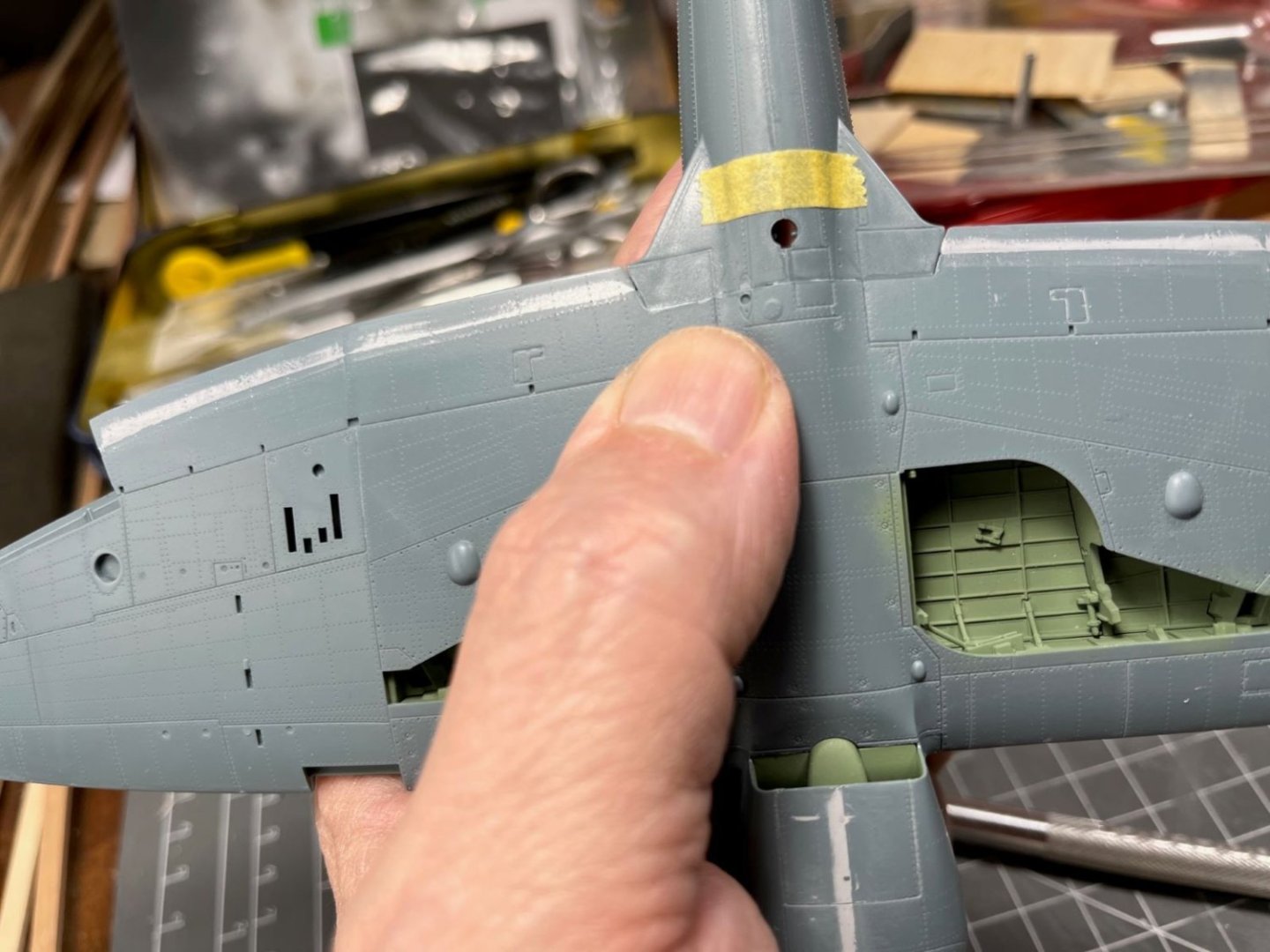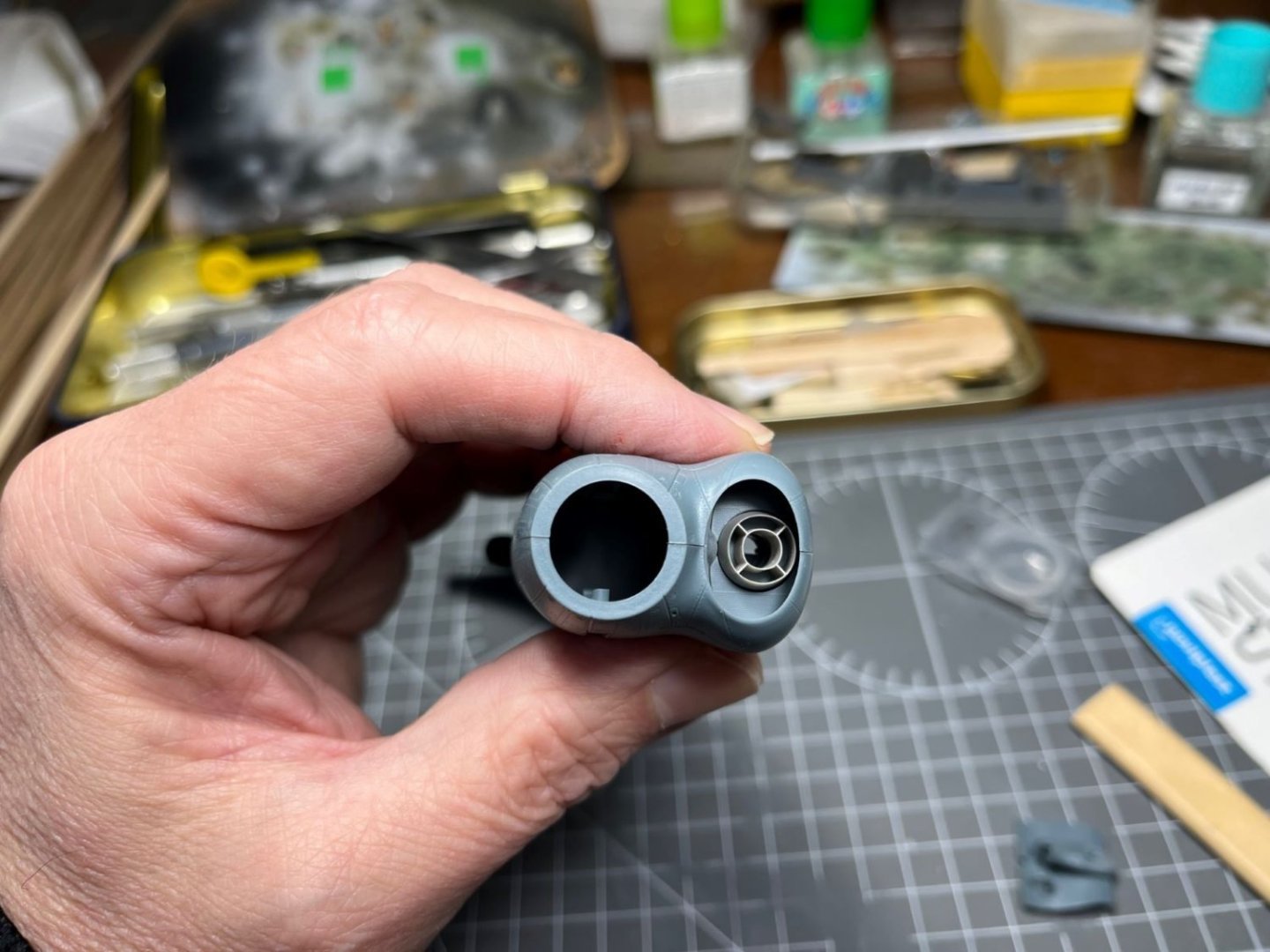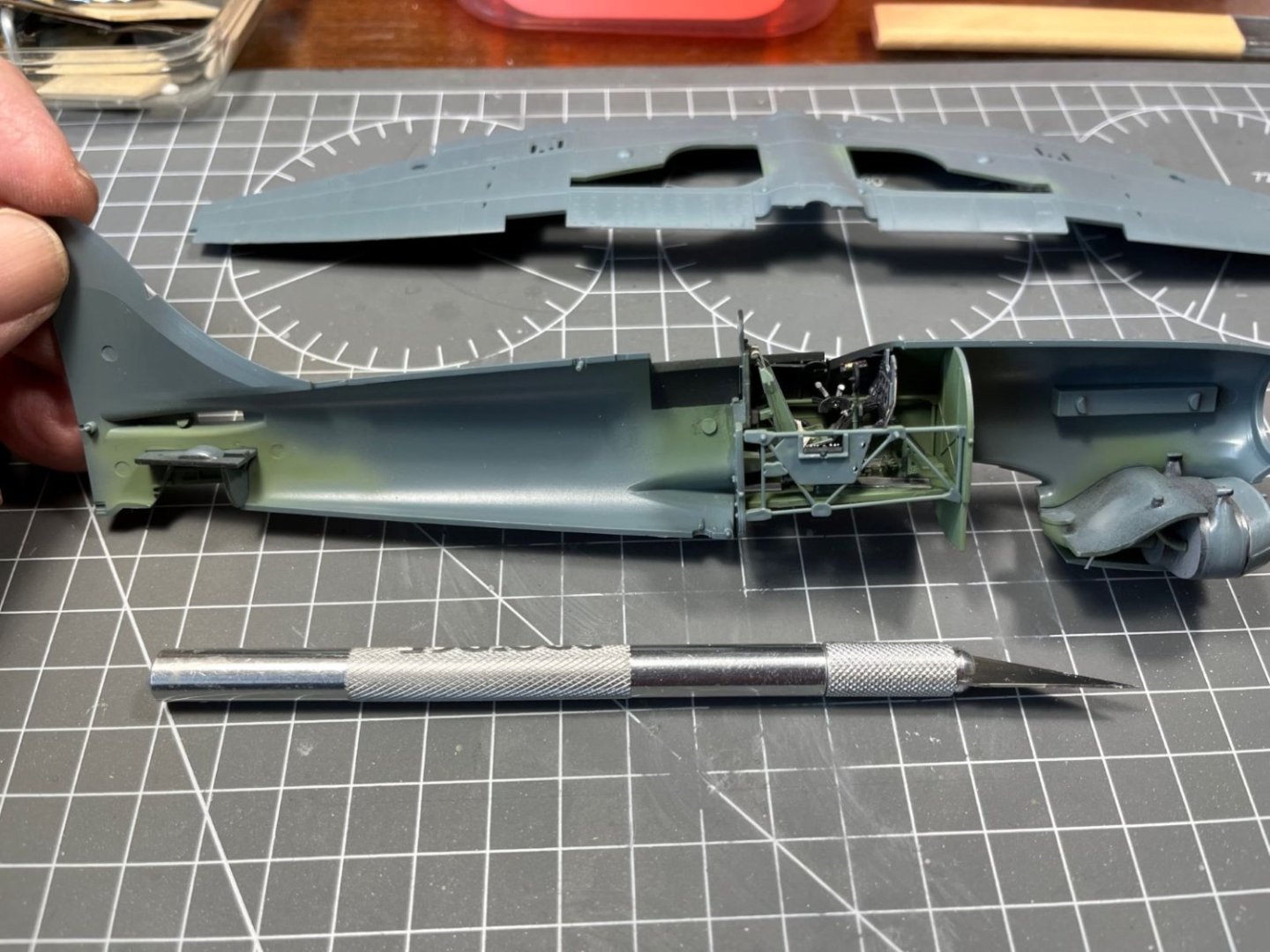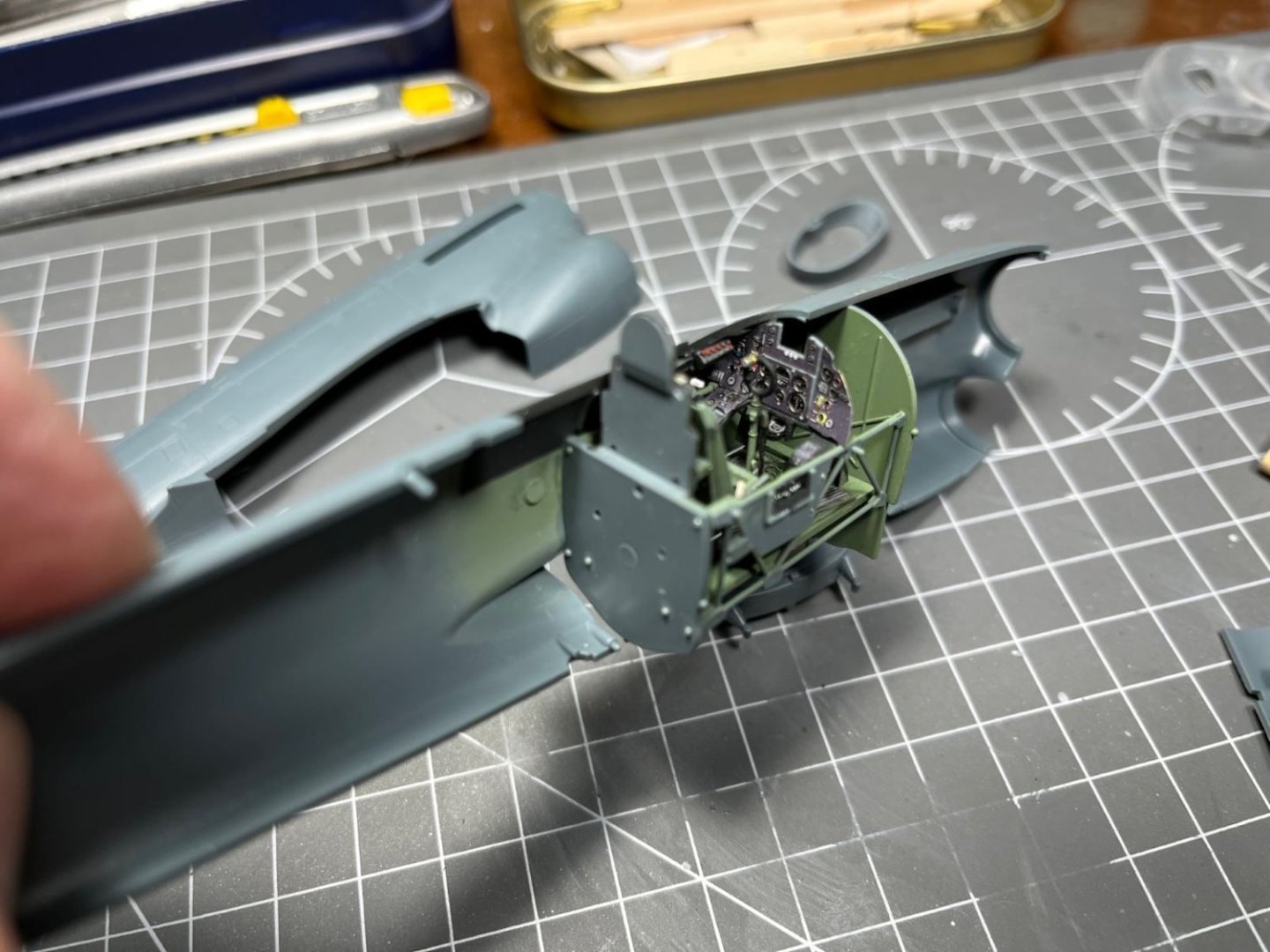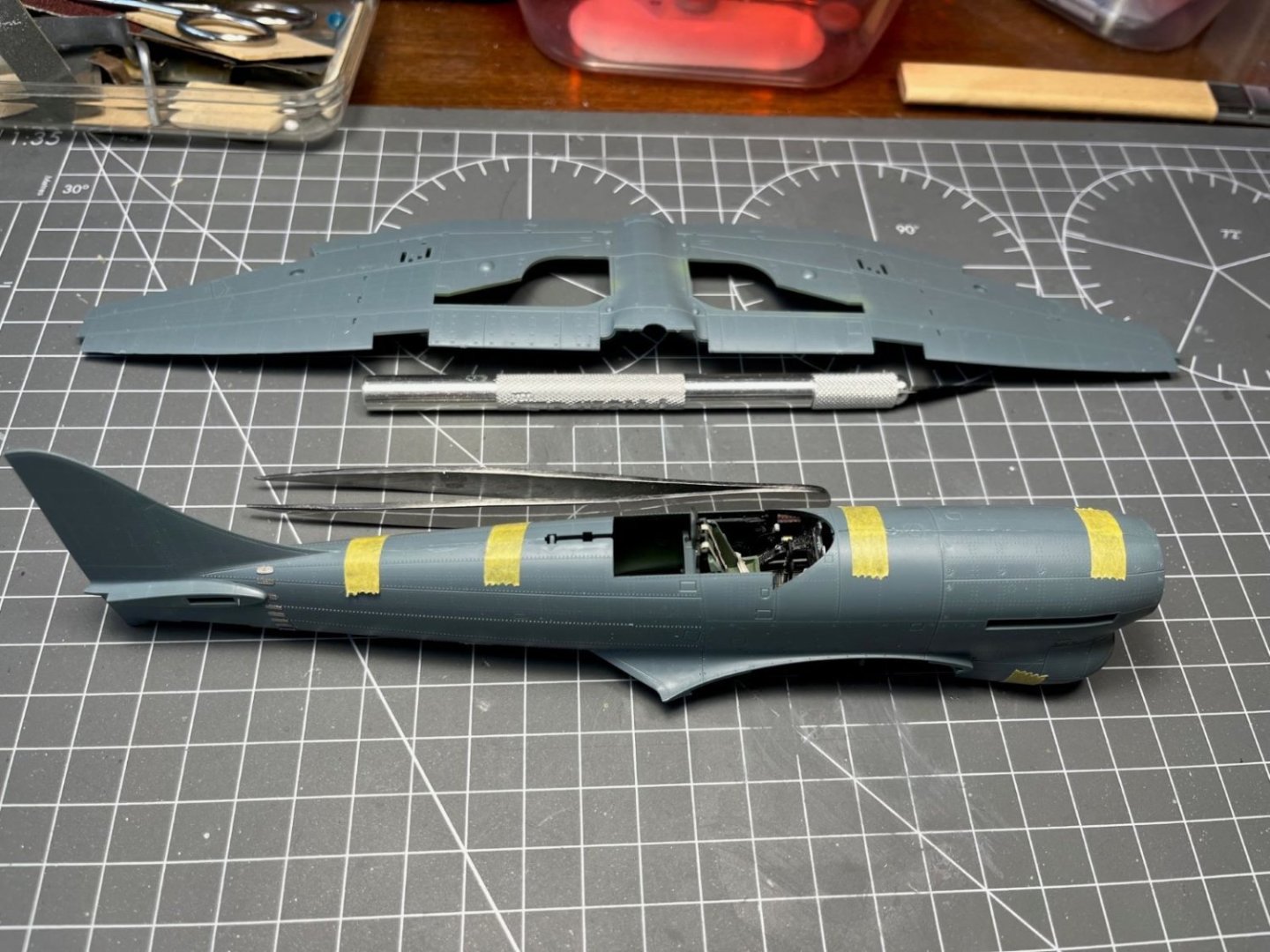-
Posts
540 -
Joined
-
Last visited
Content Type
Profiles
Forums
Gallery
Events
Everything posted by Danstream
-
Hi all, few more steps with the Tempest. I started to lay down the first layer of sea medium gray on the bottom in a semi-random pattern to create tonal variations. I realized that it is better to put on the various lights at this stage (actually, perhaps it would have been better to install them before closing the wings). I sanded them flushed with the wing surface and polished them to restore their transparency. After that, I switched to the white areas that will be required for the invasion stripes. I chose one of the scheme with the full invasion stripes which, although more complex to paint, is in my view more spectacular. I wanted a slight off-white hue, so I added a bit of grey to the white paint and I kept the layer transparent so to let some of the black to be seen through (although the effect is not very noticeable in the pictures). As said earlier, the surface details of this kit are very good and this can be noticed on the painted surfaces: However, the kit has also some small drawback that I discovered during the assembly, but overall I am quite pleased with it. Great, you will enjoy it, when you start with the cockpit, pay attention with the truss structure of the cockpit, it can break just looking at it. Hi Craig, I will be located at (or close to) Cape Canaveral. Cheers, Dan
-
Hi all, life keeps me away from the hobby room, hence I have only few progress to show. I have completed the assembly of the airframe and glued the last left fishplate. Here, the wing root junction filled with a very thin sprue wire. The nice interior cockpit will be practically invisible when the last closing part will be glued on. The tail surfaces were completed with the controls in their neutral position. I moved only the trim tabs slightly. Finally, masking with the provided masks for the transparent parts and with kleenex tissues for the rest in preparation of the primer was also completed. After spraying a black primer, a black beauty emerged: I will have to fix few blemishes before progressing with the paint, but the paneling and riveting is very noticeably good. I am progressing slow because of my work that after about twenty years will bring me again in the States, in Florida, on the second half of June. I am very excited about that. That is all for now, best regards, Dan
-
Following your comments to my build, I took the opportunity to follow your link to this build of yours. That's simply amazing, your carvings are exquisite miniatures. I will take my time to go through your posts, but for sure I will shamelessly try copying your techniques. You already resolved some of my troubles I had in continuing the second planking of my build. kind regards, Dan
- 204 replies
-
- kitbashing
- Woodcarving
-
(and 4 more)
Tagged with:
-
@Katsumoto Bedankt voor je mooie woorden! Peter, thank you for your kind words, you make me blush 😄! I am glad you like my build. I know I am going sooo slow, it is because I am not a ship builder and also because I am distracted by other modelling works. Thanks also for the many 'like's. Dan
- 42 replies
-
- first build
- artesania latina
-
(and 1 more)
Tagged with:
-
Hi all, I resumed my build of my Mayflower after one and half year. I managed to build the extension of the upper deck and to bend it as necessary. It was built of a 3-layers 1.5 mm plywood and I chose the layer orientation that offered the least resistance. I bent it soaking it in water and heating it on a curved steel cooking pot. Once glued in place, the junction was smoothed and this is the way it looked: meanwhile, I furnished the poop cabin bulkhead and finished the bulwark of the mid deck. Some pictures after gluing the deck planks: That's all for now, kind regards, Dan
- 42 replies
-
- first build
- artesania latina
-
(and 1 more)
Tagged with:
-
Hi, just to show you my progress on the split flap repair. This is how it looks after filling with sprue, filler, engraving new lines and rivets: Actually, it is not easy to see the result, hence I sprayed some Surfacer to get a grey, uniform finish: Getting there, but the picture close up revealed few blemishes that I still need to address (I also made an incorrect rivet line). Best regards, Dan
-
Yes, I agree with that. But as @Egilman said, it is a sort of artistic license. I consider the model as a 'reproduction' of the real thing, which is different from scaling it down 48 times. That means that it has to convey the feel of the real thing, with its volumetric presence and its multitude of surface details. Of course, one can bring it to a level of exaggeration such that it easily appears ridiculously fake. There is another technical aspect that I consider important: once you have a model with negative panels, I find that having the bottom of the grooves not darkened, makes the model to appear more like a toy, while having them darkened gives it a more realistic look, perhaps because light is trapped better in the grooves and it is less reflected off. @CDW, at any rate, in the last posted pictures above, the panels look great in my opinion. Dan
-
.thumb.jpg.c459ce4140b54c12eddb8eedfd446df3.jpg)
B-25 C/D by Javelin - FINISHED - Airfix - 1/72
Danstream replied to Javlin's topic in Non-ship/categorised builds
You made a remarkable display, Kevin. It freezes a moment of action very well. The model also looks very good, but I guess the display takes all the attention. Kind regards, Dan -
@Egilman, @mtaylor, I don't know the reason for splitting the parts like that. I could think that that might easy the design of the molds or avoid problems of production. Anyway, in one of their aftermarket lines, Eduard offers a flap replacement for those who wants to pose the flap deployed. This flap is a metallic, rectangular panel and the molded parts on the kit parts need to be cut and removed. I might consider that for the next Tempest (I have also a Tempest mk II to build, which I would like to finish with a High Speed Silver livery). Kind regards, Dan
-
@CDW, yes the molding of the kit is really good, it is a pleasure to look at. Perhaps, the tri-dimensionality of the details might be a tad overdone, but it looks extremely good. The riveting tool is a 'RB Production - RB-T010' (https://www.aviationmegastore.com/en/modelling/rivet-r-mini-rivet-tool-rb-productions-rb-t010-90405.html) It is quite cheap and works reasonably well. You have to use the tool head with a normal blade holder. Kind regards, Dan
-
Thanks Javlin. Indeed, lot of power, lot of striking weapons. I went on with assembling the upper halves to the lower part. Note the nice details of the landing gear wells. The trailing edge of each wing is part of the upper half. While this solution gives a neat trailing edge, the junction line, which is now on the lower surface, needs some care. Here, the right half is still untreated, while the left received some Tamiya putty to conceal the junction line. After sanding, this is the result: I restored the rivet lines that were obliterated with the tool shown above. Other minor filling were required on the forward parts of the fuselage, while the rear part is just fine with the glue oozed from the junction which will require only some sanding. Inside the air intake of the chin radiator, there was a tiny gap left which I filled with water based Vallejo filler. This is ideal for these small corrections which are in areas difficult to access. In fact, you can simply clean off the excess with a wet cotton swab without the need of any sanding. Once the wing was finished, I glued it on the fuselage. However, there is a problem with the junction on its lower surface, close to my thumb in the picture below: The problem is with the surface of the split flap which should be an uninterrupted rectangular part. Instead it is crossed by the fuselage-wing junction lines. I will address this detail next, by filling the gaps with stretched sprue wires. To the next instalment, kind regards, Dan
-
Hi, I resumed my Tempest and made some little progress. I bought the Eduard resin for central circular radiator which really is a fine addition to this nice kit. Cockpit completed and all the necessary elements were painted and added to the half fuselage. Finally the halves went together with no problems: That's all for now, wing will come next. Cheers, Dan
-
.thumb.jpg.c459ce4140b54c12eddb8eedfd446df3.jpg)
Handley Page Heyford by RGL - FINISHED - Matchbox - 1/72
Danstream replied to RGL's topic in Non-ship/categorised builds
At the beginning of your build, I wrote: Actually, you greatly surpassed my prediction! You have an awesome model, full of lovely details. Congrats, Dan -
Dear all, I am not very responsive in these days, because I am busy with my 'other' work and I will be also busy with repainting the rooms of the house (which FS no. I am going to use, you might wonder). Hence, my modeling output rate, which was anyway very slow, will go down to zero for the next couple of weeks. I will continue to read about your progress though. Best regards, Dan
-
.thumb.jpg.c459ce4140b54c12eddb8eedfd446df3.jpg)
Handley Page Heyford by RGL - FINISHED - Matchbox - 1/72
Danstream replied to RGL's topic in Non-ship/categorised builds
Great! With some care, it should turn out a beauty. Does anybody know the reason for that 'inverted' configuration? Cheers, Dan -
Hi all, after my post above where I referred to Tamiya XF-54 for the RAF ocean grey, I searched on internet and found that this color is not a good match because apparently it doesn't have enough blueness. Not wanting to give you wrong indications, I am writing this correction. However, Tamiya is now producing their XF-82 which is supposed to match specifically the RAF OG. Perhaps, you could search for this paint just to get some clue about how it looks like. Obviously, I will get this latter color for my model (or the equivalent Gunze). Cheers, Dan
-
Back to my Tempest, I finished the office which took some time because composed by many small parts and photoetched included in the kit. Cradle made of tubes, typical of Hawker of that period (stressed skin, frames and stringers from the tail to the cockpit rear bulkhead, tubular truss for the cockpit to firewall and engine bearer made also with a tubular truss). Unfortunately, I forgot to thin the edges of the seat which are obviously too thick. Now it is too late and I will have to live with that. Then, the nice photoetched IP made of five parts: (excuse my big fingers dirty of paint). The cockpit posed inside the fuselage: Probably, not much will be seen once the fuselage is closed up. This is a dry fit: That is all for now, preparing the chin radiator that needs to be included when closing the halves. Cheers, Dan
-
Thanks Mark! That's the reason I took that pictures. I had momentarily put the model on the sill and it looked so cool that I quickly took a picture of it. Thanks Andrew, I spent an awful lot of time with that model, I also riveted it, enlarged the diameter of the rear fuselage, added new vortex vanes, etc., etc. Practically there wasn't a single piece of the kit that I didn't not scratched or modified. But at the end of the day, I was quite satisfied with the results. Dan
-
Indeed, Re-scribing is a real chore, usually I do the strict necessary to restore panel lines after filling and sanding of junctions, but this time I re-scribed everything and corrected some inaccurate paneling pattern. In many cases, I had to redo lines because slipping and scratches, not always l had luck at the first attempt. Thank you for your compliments, Dan
About us
Modelshipworld - Advancing Ship Modeling through Research
SSL Secured
Your security is important for us so this Website is SSL-Secured
NRG Mailing Address
Nautical Research Guild
237 South Lincoln Street
Westmont IL, 60559-1917
Model Ship World ® and the MSW logo are Registered Trademarks, and belong to the Nautical Research Guild (United States Patent and Trademark Office: No. 6,929,264 & No. 6,929,274, registered Dec. 20, 2022)
Helpful Links
About the NRG
If you enjoy building ship models that are historically accurate as well as beautiful, then The Nautical Research Guild (NRG) is just right for you.
The Guild is a non-profit educational organization whose mission is to “Advance Ship Modeling Through Research”. We provide support to our members in their efforts to raise the quality of their model ships.
The Nautical Research Guild has published our world-renowned quarterly magazine, The Nautical Research Journal, since 1955. The pages of the Journal are full of articles by accomplished ship modelers who show you how they create those exquisite details on their models, and by maritime historians who show you the correct details to build. The Journal is available in both print and digital editions. Go to the NRG web site (www.thenrg.org) to download a complimentary digital copy of the Journal. The NRG also publishes plan sets, books and compilations of back issues of the Journal and the former Ships in Scale and Model Ship Builder magazines.


